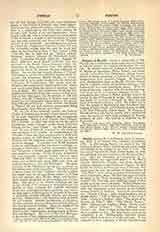

Finnian of Moville, Saint, b. about 495; d. 589. Though not so celebrated as his namesake of Clonard, he was the founder of a famous school about the year 540. He studied under St. Colman of Dromore and St. Mocha of Noendrum (Mahee Island), and subsequently at Candida Casa (Whithern), whence he proceeded to Rome, returning to Ireland in 540 with an integral copy of St. Jerome’s Vulgate. St. Finnian’s most distinguished pupil at Moville (County Down) was St. Columba, whose surreptitious copying of the Psaltery led to a very remarkable sequel. What remains of the copy, together with the casket that contains it, is now in the National Museum, Dublin. It is known as the Cathach or Battler, and was wont to be carried by the O’Donnells in battle. The inner case was made by Cathbar O’Donnell in 1084, but the outer is fourteenth-century work. So prized was it that the family of MacGroarty were hereditary custodians of this Cathach, and it finally passed, in 1802, to Sir Neal O’Donnell, County Mayo. St. Finnian of Moville wrote a rule for his monks, also a penitential code, the canons of which were published by Wasserschleben, in 1851. His festival is observed on September 10.
W. H. GRATTAN-FLOOD

